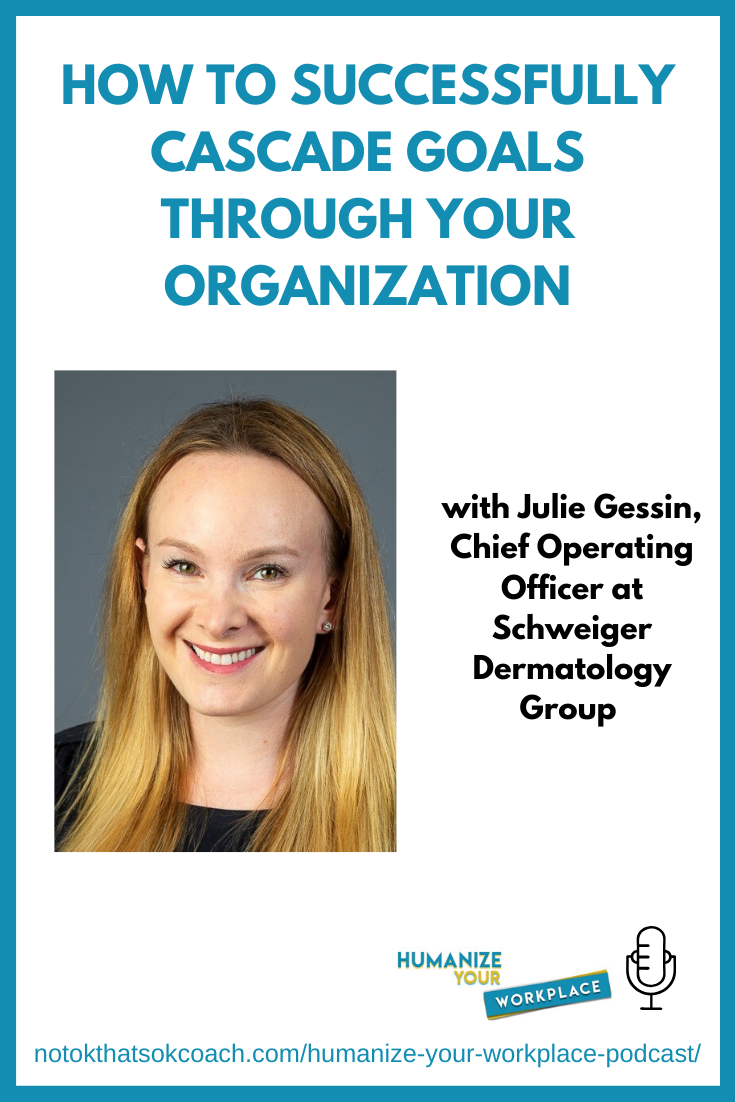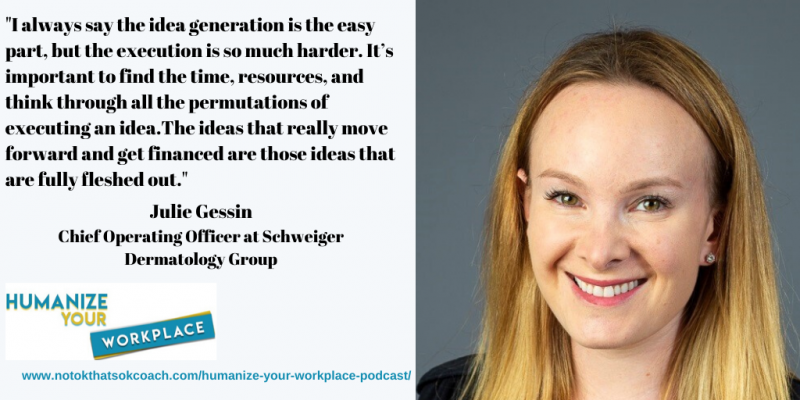On this episode of Humanize Your Workplace we are joined by Julie Gessin, PA-C. Julie is a licensed Physician Assistant and in the executive suite at Schweiger Dermatology Group where she serves as the Chief Operating Officer. She oversees 600 employees in 50 office locations and leads the business growth efforts through acquisition integration and starting new offices. She also oversees and founded the pathology department, business intelligence, in-house call center and the centralized training & onboarding program.
We chat about:
- how to identify company-wide goals
- how to cascade and communicate these goals throughout the organization
- how to hold yourself and employees accountable for reaching these goals on a weekly, monthly, quarterly and year end basis
To listen to this week’s episode, head over to Google Podcasts, Spotify, Apple Podcasts, or Stitcher, check it out below.
Who would you like to thank for helping you become the professional you are today?
My direct boss, Dr. Eric Schweiger. I met him in 2011 and he was just starting his business and he hired me as a PA full-time. In a few years I realized that I didn’t want to just be seeing patients. Any other physician would say “that’s where your license is and you’re making my business money doing that.”
We were similar and I think he knew that if he didn’t allow me to pursue other interests, he was going to lose me one way or another. He never allowed things like lack of experience, age, or gender hold me back. He always pushes me to try to be three steps ahead and think about things others aren’t.
Can you tell us more about your organization and what type of goals you might be working towards?
Our leadership team (13 people) takes two days off-site in early October and we set our company goals for the next year. We put all of our personal goals or things that we think we want to accomplish on the wall and then we go one by one as a group and decide.
These are high-level goals involving growth, patient satisfaction and more with sub goals in between them. We then agree on five goals.
I then share those goals with my direct team, and we come up with the same cadence by determining what goals feed up into these? So, when you get down to office level staff you realize what they can and cannot affect.
When you get down to the medical assistant level or the front desk or the provider or the general manager then you start to weigh the goals. The general manager is patient facing and has the highest touch of a patient, then maybe 50% of their KPIs would be around patient satisfaction. That’s how we cascade our goals down and make sure that everybody’s looking at something and nothing can get missed. So, if no one has employee satisfaction on their goals we go back and reevaluate.
Are there questions or other gauges that your group goes through to come up with those
Revenue: How do we make money? How do we stay in business?
Patient satisfaction: Are there things that if we don’t do next year patients won’t come back? Are there other things that the industry is changing, and we have to do?
Employee engagement: What makes people want to work here? Why do people work at this company? Why do they stay at this company? What are they leaving for?
Those are the biggest categories that we focus on. If we don’t have happy employees, we won’t have happy patients and if we don’t have patients, we don’t make money.
How often do the employees on the “ground” meet? What do those meetings look like?
The leadership team (13 people) meets every week and the management team which is all regional managers, managers that support the corporate office, and field managers also meet once a week. We talk about the goals for the managers and their direct reports which are our local managers to each specific office or each clinic. They come into Manhattan every month and we talk to them about these goals and do activities around them. It’s really a day of learning.
We’ll also have speakers come in teach high-level topics or trends that we’re seeing across the practice or best practices. It gives them a chance to interact with each other which is most important, but also see that everyone has the same pain points and everyone’s solving them in different ways.
And then when they go back to their office, they have meetings with their staff that really cascades them down. And we make sure that our regional managers are being held accountable to our local general managers.
Last time we talked you mentioned a red light, green light method to sharing with your team where you are with your goals. Can you share a little more about that?
Every week we have a commitment that feeds into that goal. Let’s say my goal is to increase patient satisfaction from 78 to 80 as a Net Promoter Score. There will be lots of sub bullets under that and I have to make sure patients are getting their lab results and all these different things and initiatives that I’m working on. Once I commit to one thing that I’m going to do I either did it or I didn’t. If I did it, it’s green and if I didn’t do it it’s red, and yellow means you are off track, but you have a plan to get back on track.
So, each quarter we have sub goals and it really helps not getting to the end of the year and wondering if we were on track. We track this as a spreadsheet with all of our pictures every month and it’s a great way to kind of have a visual snapshot.
How do you regroup and figure out what to do next if there is a string of red?
The first thing we do is evaluate what the goal was. Business development is a really great example of this because business development is when you buy businesses and you’re only 50% of the equation. So, you don’t have control over the 50%. Even if you worked a hundred hours a week and you were doing your best work, it may not be your fault in which case was that really a good goal? Were there are other things you could have done that are within your wheelhouse and within your control to move forward?
If it’s fixable we come up with a plan and we fix it. And if it’s more infrastructure or things aren’t sticking or the plan was one thing and now, we’re realizing that was a bad plan, then we give ourselves the accountability to go back and reevaluate.
So, it’s not just you wake up one day and say I don’t like that goal I want something else. And it has to always roll into those five company priorities. It’s easy to get off track but that’s not going to ever roll up into our company priorities. So, it’s evaluating up.
How have employees gotten their ideas approved by your organization’s decision makers?
I think we no shortage of great ideas and that’s not my company that’s across the board. I talk to people all day long who have amazing ideas and want to execute them, but I always say the idea generation is the easy part, but the execution is so much harder. It’s important to find the time, resources, and think through all the permutations of executing an idea. If it does fallout, what’s going to happen? How do you train on that? What about someone new to the organization, how do they learn this all these things?
So, what we really encourage is whoever it is coming up with the idea and submitting it, is to go through a change management process. They’re flushing out ideas and presenting a business case to the group. The ideas that really move forward and get financed are those ideas that are fully fleshed out.
I had someone who had a great idea for the call center but to execute would be a really big change and they wanted more people. The truth is, generally it’s not more people it’s better training and technology. I had them start thinking about a business plan and then meeting with stakeholders one on one to ask the questions. Then they presented their idea and got a few people’s different feedback.
- Cultivating Relationships - July 20, 2021
- Empowering Our People - July 13, 2021
- Finding Purpose - July 6, 2021





